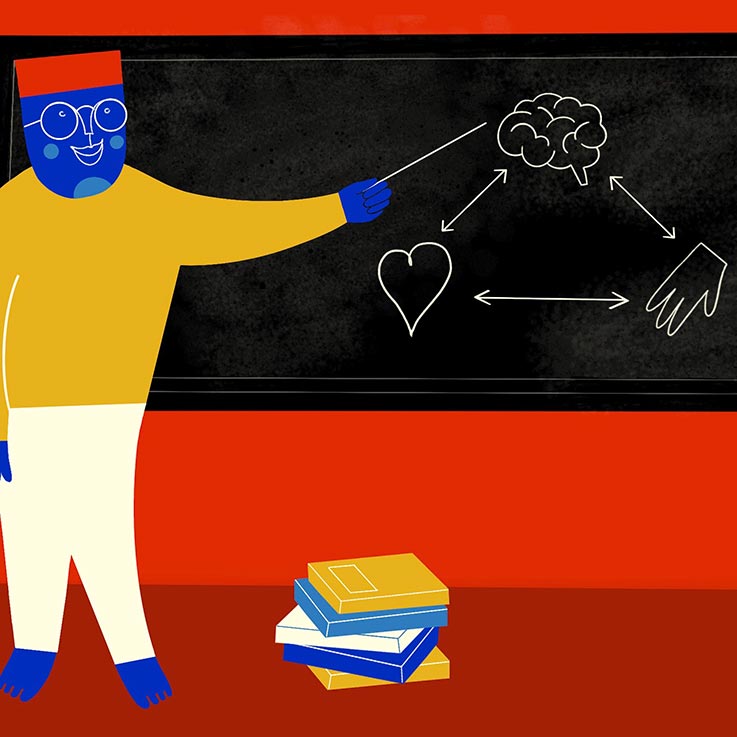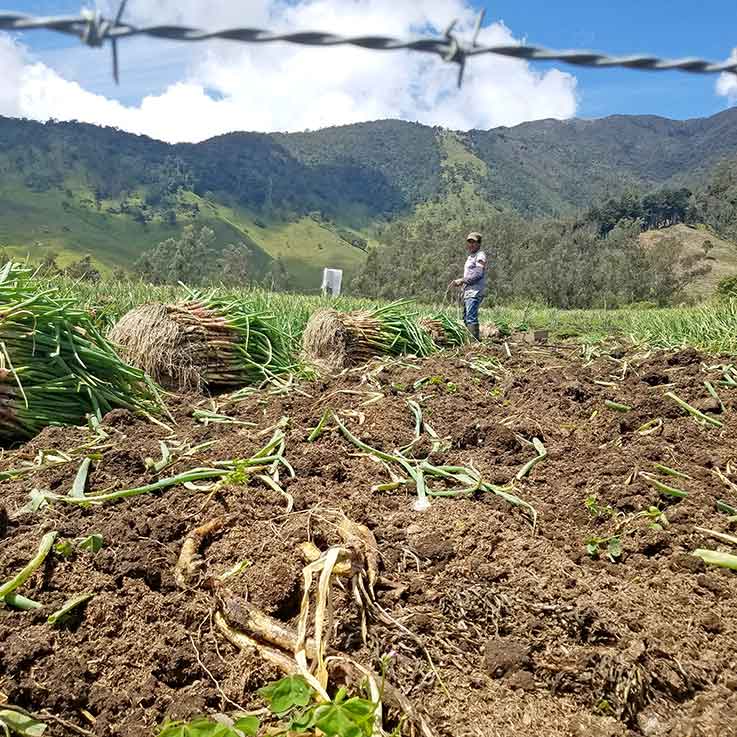
Connecting Inner and Outer Well-Being in Social Innovation Education
Connecting Inner and Outer Well-Being in Social Innovation Education
Why social innovation education programs need to develop students’ inner well-being alongside their knowledge of the field, and five principles to help lead the way.
By Aneel Chima & David Germano Nov. 18, 2020
(Illustration by Helena Pallarés)
Rethinking how universities, nonprofits, and training institutes educate the next generation of social innovators is both a responsibility and a challenge for the social change sector. Younger generations motivated to address social and environmental problems must navigate profound shifts in their own lives, in their communities, and in the domains where they hope to engage. Change is increasingly complex in character, unfolding across multiple sectors and geographies simultaneously, and at an exponentially faster pace. Instead of being an anomaly, challenges emerging from the COVID-19 pandemic, for example, may well point to a new normal. At the same time, young people are entering the sector with significantly lower levels of well-being than their predecessors, even as social innovators already in the field are burning out at unprecedented levels. Young people, particularly those under 25, are currently experiencing steep increases in mental illnesses such as depression and anxiety.
Taken together, these challenges make it clear that social innovation education must invest just as much time and effort in developing the inner well-being of student change makers—those aiming to engage in building a healthy, just, and caring society—as it does in developing their expertise of systemic challenges in the outer world.
Centered Self: The Connection Between Inner Well-Being and Social ChangeThis series, presented in partnership with The Wellbeing Project, India Development Review, The Skoll Foundation, and Schwab Foundation, explores this important but often overlooked connection between inner well-being and effective social change.FOLLOW THIS SERIES
Students’ understanding of their own inner world directly affects their ability to achieve positive change and sustain themselves through social innovation work over the long-term. The change they hope to cultivate in the world is connected to cultivating and using inner skills to effect outer change. A field of social innovation that educates for inner well-being both theoretically and experientially—where more experienced change makers model it and mentor the next generation—would be more resilient, less prone to causing burn-out, better able to navigate social challenges, and ultimately more effective at promoting a healthy and sustainable world.
To encourage this shift, The Wellbeing Project (TWP), along with Stanford University’s division of Health and Human Performance and the University of Virginia’s Contemplative Sciences Center, created an international consortium of teams from universities and institutes called The Wellbeing, Innovation, and Social Change in Education (WISE) Network in 2018. The network is dedicated to developing educational models and methodologies that support student and sector well-being, and sees well-being as an essential element of promoting positive social change. WISE education models integrate insights from the fields of neuroscience, behavioral epigenetics, psychology, applied humanities, and the arts to understand the factors that optimize emotional, psychological, social, and physical “flourishing”—the development of our full potential and a deep sense of well-being. The network believes that flourishing arises from the integration of well-being, contemplation, and social innovation, and that it occurs via engagement within ourselves, in our relationships, and with the world. When successful, it has the power to positively change individuals, communities, and societies.
Flourishing in Theory and Practice
During an 18-month developmental period, from December 2018 through June 2020, the co-creators of WISE identified and engaged with nine other institutions to explore new ways for imbuing social change education with well-being practices. Each organization had a significant program in social innovation; was interested in considering how their program could better facilitate student flourishing through inner well-being work; and contributed to the geographic, cultural, and institutional diversity of the group.
The developmental phase included a series of in-person and virtual gatherings where participants shared experiences and knowledge, and formed working groups. Organizations also explored models, measures, and practices of flourishing; planned systemic well-being training interventions; and designed and deployed efficacy assessments to measure impact. Research unfolded at the institutional level (what made each program unique based on its cultural, geographical, and social context), as well as across the group (what was generalizable across all organizations). The core question animating our work was: How do we teach future social innovators to integrate well-being frameworks and practices into their work in a way that produces measurable impact? Because of the diversity of participants, we learned how variable, flexible, and adaptable these approaches needed to be.
From this, we identified five principles that can help inform the creation or refinement of education programs seeking to successfully integrate well-being into their missions. We suggest that programs apply them during the conception, implementation, and assessment phases.
1. Define Flourishing Explicitly and Locally
Reinventing educational models to include inner development requires ongoing institutional commitment and articulation. It also requires acculturation of definitions and models of flourishing that inform program details, assess the impact of projected interventions, and highlight the importance the institution places on the use and significance of those interventions. Effective programs go beyond conventional mental-health support, and explicitly identify and support the positive physical, social, contemplative, and economic dimensions of well-being most relevant to their students and their institution.
Indeed, adopting existing well-being models and then evolving, adapting, or replacing them for greater cultural relevance was one of the most robust and important early learnings from the network research. Broadly speaking, we found that most prominent contemporary models of well-being are rooted in Euro-American value systems and cultures. As institutions adopted and began to implement them, the limitations of these models—including innate cultural biases and a tendency to focus on emotional well-being through a highly individualistic lens—became clear. As a result, we began looking to additional models, such as the Organisation for Economic Co-operation and Development (OECD) Framework for Measuring Well-Being and Progress (which incorporates income, work, housing, and environment) and Stanford WELL for Life survey (which includes physical health, finance, and spirituality/religiosity, and has been studied in cross-cultural environments).
We also encouraged institutions to adopt frameworks and practices from their own cultural contexts, in order to construct more culturally resonant and contextually appropriate models. For example, Koc University in Istanbul, Turkey, initially adopted the PERMA model of well-being, originally conceived at University of Pennsylvania. However, it discovered it needed to build a model that was more relevant to its cultural context. Animating the model with local language, concepts, images, and stories that resonated with students, faculty, and staff enhanced the implementation, integration, and effectiveness of the model. Similarly, what worked at Stanford University with undergraduate students only partially transferred to the context of post-graduate education in the Women Influence Power Program at the University of Cape Town, and vice-versa.
2. Promote Well-Being Individually and Systemically
Research literature and case studies underline the need to consider changing how we think about inner well-being and its role in social change. In the realm of social innovation education, we need consider how existing educational systems may operate at the expense of student well-being. Reexamining incentive structures for students and faculty, exploring how to better protect student work-life balance, and “practicing what we preach”—both broadly and within local contexts—are all essential for creating a culture of well-being.
The network’s 11 pilot interventions varied in shape and size; they included academic and curricular programming, long-term fellowships, one-off workshops, and short-term co-curricular programing to community support. Successful programs found a way to teach students how to cultivate their own personal well-being, while also promoting an organizational culture of well-being through program structure, implementation, and contextual factors. For example, the team from University of North Texas at Dallas focused on how innovations in designing and building a signature, mixed-used space (form) could facilitate the transformative programs, activities, and experiences supporting student well-being that took place in that space (function). This new space also served as the symbol of a larger commitment by the university to bring well-being practices into the everyday lives of students across programs, in a way that integrated curricular, co-curricular, and extra-curricular experiences.
3. Design Experiential and Practice-Oriented Programs
Each participant in our network chose to build, refine, and/or redesign various types of training and education experiences, including workshops, lecture series, courses, and entire programs. The Indian School of Development Management (ISDM), for example, focused on a year-long residential program for matriculating students; the University of Virginia team focused on a year-long, non-residential program for global fellows; and the Nelson Mandela School of Policy and Governance at University of Cape Town focused on a three-day residential retreat for emerging female leaders across the continent. As we examined the specifics of these programs, three insights emerged.
First, social support is the most important predictor of well-being. Programs should aim to foster positive social connections, a sense of belonging, and community formation organized around shared aspirations and practices of well-being. Mexico-based university Tecnologico de Monterrey, for example, prototyped a series of half-day workshops that mixed interactive design-thinking methods with experiential well-being learning exercises in a festival-like environment. This built cohesiveness, belonging, and connection among students, as well as enfolded them in the creation of well-being supports services for their larger learning journey. Other teams took learning into more social, informal environments outside the classroom to foster social connection. Still others launched formal and informal peer-support projects ranging from peer-coaching to expert- and peer-led workshop series.
Second, programs should explore flourishing experientially, not just didactically. Cultivating well-being is deeply personal and takes many forms. ISDM drew on Indian wisdom traditions that take a holistic well-being perspective, emphasizing that well-being is not outside of you but part of you. The program wove this perspective into academic advising, course content, and other areas to generate a highly personal and experiential narrative around well-being.
Finally, changing habits and practices is important. Contemplation in particular—whether via meditation, or somatic or aesthetic practices—helps students become aware of current patterns of thought and behavior, and effect deeply rooted change. It also helps inform their life experience and engagement with others. During its annual gathering of international fellows, the University of Virginia emphasized contemplative practices throughout its proceedings to build communities of practice. It also integrated new contemplative practices and fellows' experiences into monthly coaching calls.
4. Build a Feedback Loop Between Inner Practices and Outer Actions
It’s essential to create a feedback loop between the inner world of the student and their outward work in the world; this enables them to self-reflect on how they impact the world and how the world impacts them. One vehicle for doing this in social change education is purpose.
In collaboration with Project Wayfinder, for example, the Stanford Flourishing Project built a purpose-based education model for a series of courses within its Wellness Education program. The learning model, which programs can apply across a range of topics and classes, asks students to:
- Define what is personally meaningful to them through a series of reflective and interpersonal exercises
- Create an intention to accomplish something of impact in the world through design-based methods
- Ensure that the actions they take serve the world wisely, supported by interviews with mentors and exemplars
- Adopt a “learn by doing,” project-based approach, informed by skills that build resilience, creativity, social connection, and overall well-being
This method, which puts Stanford Professor Bill Damon’s work into practice, helps support one of the most important milestones in a young person’s developmental trajectory: engaging in the inner and outer cycle of purposeful living.
5. Generate a Continuous Cycle of Knowledge Gathering and Program Refinement
Social change education takes place in many contexts. In our work with a diverse group of organizations, we learned to balance generalizable measurement strategies that work for all members with individualized approaches to assessment at the local level, using a three-pronged approach:
- Quantitative methods that use metrics standard to the field of well-being, such as Keyes Mental Health Continuum and Diener Flourishing Scale
- Qualitative methods that foster a deeper understanding of contextual factors and provide more dimensional data about the impact of pilot program, such as specific cultural values
- A design-based, iterative approach of “learning by doing,” which includes generating learning feedback loops to refine prototypes (of programs, workshops, and classes) and continually test their efficacy
Together with the University of Wisconsin-Madison’s Center for Healthy Minds, we built a general group assessment that mixed quantitative questions with qualitative questions and included a range of demographic variables. From there, we investigated factors unique to the context of each individual institution. Finally, we adopted a design-thinking approach to create a continuous feedback loop between the prototypes the institutions were constructing and testing, and a refinement process that incorporated learnings and suggested adaptations.
Toward a Flourishing Future
The next phase of the WISE Network will engage up to 100 universities globally, all of which aim to foster flourishing among future generations of social innovators. Building on the five principles above, we aim to share knowledge and resources, spark collaborative program-building and research, and develop best practices across the network.
In a world of perpetual, pervasive, and exponential change, social change leaders are best equipped to address challenges when they develop both the internal and external skills they need to generate well-being. Given the evolving nature of change and unprecedented challenges to the mental health and well-being of change makers, particularly younger ones, well-being education is no longer an optional add-on. It must be at the center of how we educate the current and next generations.










